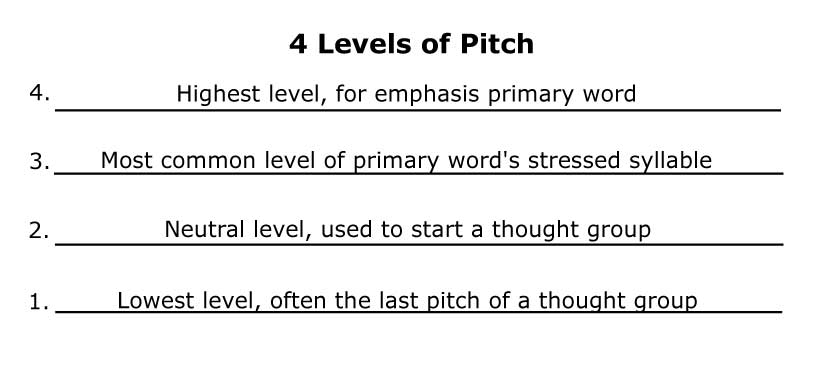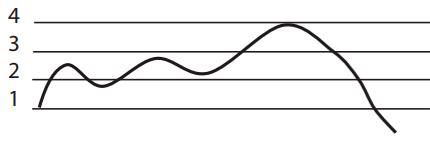When to Use Rising and Falling Inflection
When thinking about inflection, we consider how the pitch rises and falls in a sentence to help convey the message. Inflection is a key element of the English language; it can help us understand if the speaker is asking a question, making a statement, or conveying emotions such as disbelief or surprise. Once you can identify when to use different types of inflection, you can greatly improve your American English communication skills.
Before understanding how falling and rising inflection work in American English, it is important to know the four levels of pitch in a sentence. They are as follows:

The 4th level of pitch is used to emphasize or show strong feelings in an utterance, whereas the 3rd level of pitch is just below, indicating the primary stress in the sentence. Being able to detect the primary stress in a sentence is crucial to understanding the speaker’s message – see our post about it here. The 2nd pitch level usually begins the sentence or thought, and the first level indicates pitches that are below the rest.
Falling Inflection in Declarative Statements
Falling inflection is used to indicate complete messages, separate thoughts, “wh-” questions, and declarative messages ending with a period. Let’s talk about declarative statements first.
A declarative statement is simply a statement of a fact. These are used more commonly than we even realize, which is why it’s even more crucial to understand how falling inflection impacts declarative statements.
Regardless of where the stress is in a sentence, simple, declarative sentences use falling inflection. If the sentence is a statement of fact or opinion, the pitch starts low on first word, at pitch level 1 (see above). It then raises high (pitch level 4) on the stressed word. The pitch then falls all the way down (back to, or even below, pitch level 1) at the end of the sentence. See below:

Use the graphic above to consider the following declarative sentences, with the primary stress word in bold:
- Our car broke down.
- I went to the park today.
- She sang at the bar last night.
To learn more about declarative sentences, check out this link for a guided tutorial with practice.
Falling Inflection in Questions
Falling Inflection is most commonly heard in a certain type of questions: “wh-” questions. “Wh-” questions include those starting with “who”, “what”, ‘where”, “when”, “why”, and sometimes “how”. These are questions that have answers that may be more predictable or may result in more definitive answers. For example, “When did he go to the store?” and “Who is that?” are both questions in which we can predict the answer. For the first question, the answer will be a time of day. For the second, it will be someone’s name, or an explanation of their relation to someone else (Marta’s mother, Joe’s friend, etc.).
Most often, when we ask wh- questions, it is to confirm with the conversation partner that we are correct. This is why they can be seen as more “declarative” questions, and why the inflection pattern is similar to that of declarative statements.
Slightly Rising Inflection
Now that we’ve reviewed falling inflection in its several forms, let’s move on to rising inflection. In American English, the pitch rises significantly on the key word of the sentence, gliding upward towards the last word of the sentence.
Is it / was it questions are a great example of this:
Is it difficult?
Was it cooked?
The first two words of these sentences are said rather quickly, and then the bolded, stressed word is said with a significantly higher pitch. Let’s consider sentences in which the primary stressed word is not the last word:
Is she going to eat tonight?
Do the shoes match with the jacket?
In the above two sentences, although the primary stressed word is not the last word, the pitch continues to increase until the end of the question.
If the emphasis isn’t placed on the primary stressed word, this can indicate doubt. Consider the following example, with the stress on the correct word in the first question, and on an alternative word in the second question:
Was it ready?
Was it ready?
The second sentence indicates that there is doubt that the item in question was ready at all. The first sentence merely asks if the item in question is ready or not.
As you may be able to tell, understanding the primary stress in a sentence and when to use rising or falling inflection can be key to communicating your message. This is one of the many subtleties of American English, but with this skill in your toolbox you are sure to be a more efficient communicator.
Further information
If you missed us last week, check out our last post, How to Place Stress in a Sentence!
Questions or Comments? Contact us here.
Check out our YouTube Channel! If you’re a Portland, OR local, check out our Meetup Group, classes at Portland Community College, and Intel Employee classes!
Accent Modification Accent Reduction Speaking English Speech Skills Learning American English Speech Pronunciation Intonation Vowels Consonants Talking Communication Spelling Presentation Skills Interviewing Conversation Speech-Language Pathologist Online Training Coaching Private Classes Seminars SLP Speech Therapist
Portland Oregon Hillsboro Beaverton Bethany Cedar Mill Cedar Hills Oak Hills Lake Oswego West Linn West Slope Camas Happy Valley Rock Creek Sherwood Raleigh Hills Tigard Tualatin Gresham Wilsonville Aloha Salem Eugene Springfield Corvallis Oregon City Woodburn Forest Grove Newberg Milwaukee Sherwood Canby Troutdale Cornelius
American Accent Chinese Accent Mandarin Accent Spanish Accent British Accent Indian Accent Hindi Accent Arabic Accent Portuguese Accent Bengali Accent Russian Accent Japanese Accent German Accent Korean Accent Arabic Accent French Accent Vietnamese Accent Telugu Accent Marathi Accent Turkish Accent Tamil Accent Urdu Accent
